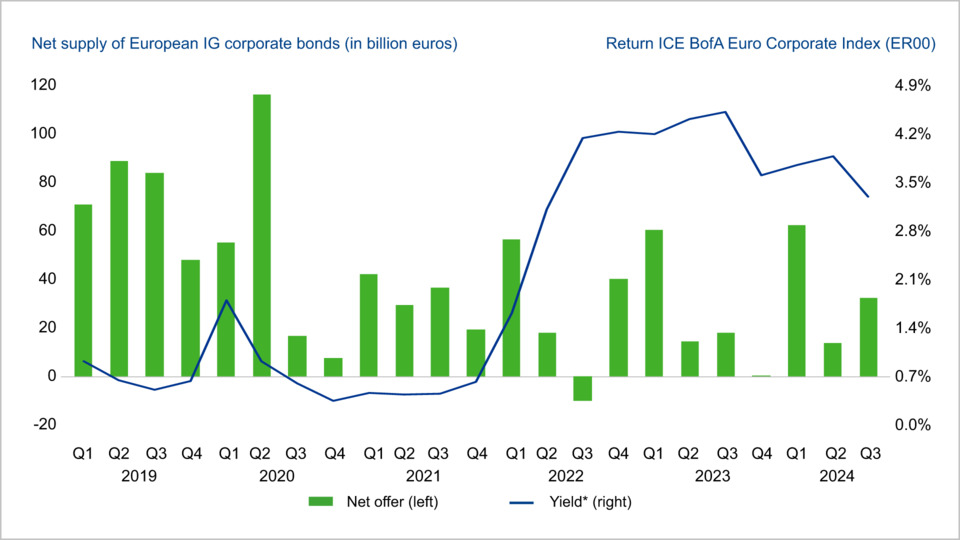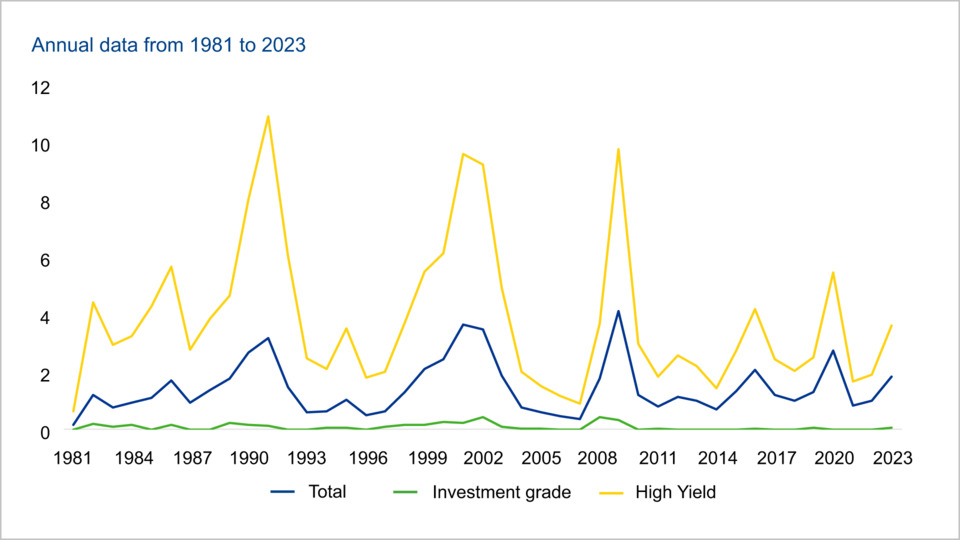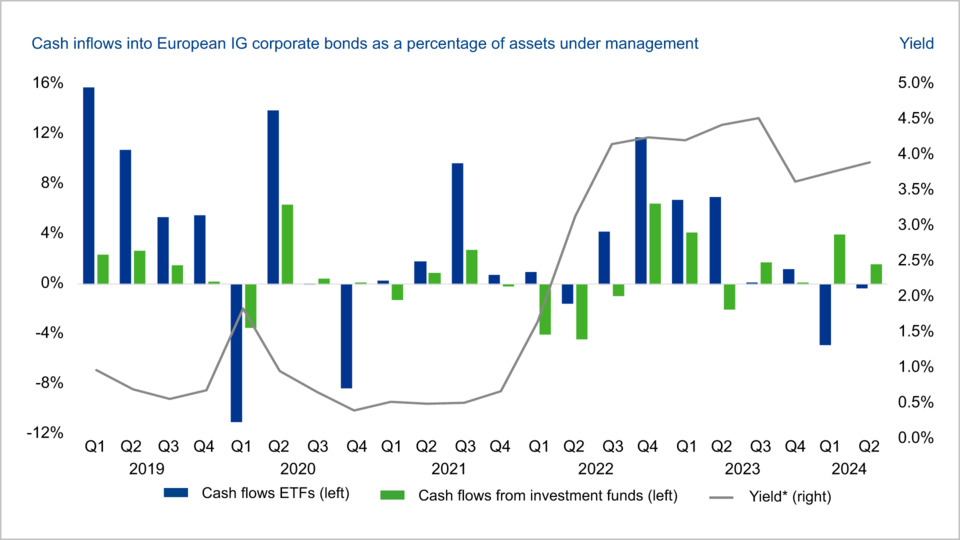
專家「聯」綫:企業投資級別債券 - 波動市況下的定海神針(只提供英文版本)

|
Investment-grade and high-grade corporate bonds continue to play an important role for a bond portfolio . They offer interesting yield opportunities in the context of falling interest rates and are fundamentally well supported – even in the event of a deterioration in market conditions.
Robust, but not excessive net supply of IG corporates

Source: Bloomberg, ICE BofA. Union Investment. As at: 10 October 2024. *Yield to maturity (ICE BofA Euro Corporate Index, ER00)
Solid fundamentals in the IG segment
However, although risk premiums are low even by long-term standards, we do not expect spreads to widen in the short to medium term. In the area of euro-denominated corporate bonds with good to very good credit ratings, the creditworthiness of the issuers offers good protection against strong market fluctuations. Our fundamental bottom-up balance sheet analysis shows that investment-grade (IG) companies as a group have solid earnings growth, an above-average return on sales and a leverage ratio that has fallen significantly since the coronavirus pandemic. Overall, business performance does not indicate an increased risk of insolvency, which should be reflected in the continued rating improvements of many companies. Moreover, the impact of geopolitical tensions on this asset class is likely to be limited. So far, it has barely reacted to the turbulence surrounding France and the US election campaign. This pattern of corporate bond spreads moving relatively little in response to political events – in contrast to monetary policy measures – has been seen in the past, for example during the election of US President Donald Trump in 2016.
Rising risk premiums in the automotive sector
However, active selection is of great importance. In the automotive sector, for example, risk premiums have recently widened somewhat due to a concentration of bad news, albeit to a moderate extent and mainly in the high-yield segment, for example The breadth of their business models makes them comparatively resilient even in the event of a possible escalation of geopolitical tensions – which is not our base case scenario at present.
Comparison of global default rates
Defaults as a percentage of the outstanding bond volume

Source: S&P Annual Default Study, Union Investment; as at 1 October 2024.
In retrospect, it is clear that the rise in corporate yields from 2021 to 2023 was hardly driven by rising risk premiums at all, but rather by the increase in the safe interest rate (the ‘government bond component’). This risk premium remains at a low level and below the historical average. Now, key interest rates are falling and yields on the bond market have switched into reverse, as further significant interest rate cuts are being priced in.
Corporate bonds as a possible alternative to government bonds
What does this mean for corporate bonds? We believe that the decline in key interest rates currently being priced in is somewhat over-ambitious. This is based on our assumption that the US economy will achieve a soft landing without a recession and that growth in other regions of the world, such as Europe and Japan, will tend to pick up again somewhat. The stimulus measures announced in China also suggest a more stable development of global growth. Even if an escalation of geopolitical tensions were to lead to a rise in risk premiums, shifts into ‘safe havens’ are likely to have the opposite effect on government bond yields and thus also on the corresponding component in corporate bond yields, so that overall the fluctuations in the area of IG corporate bonds should remain manageable.
Likewise, rising government debt also speaks against a significant widening of the yield gap between government and corporate bonds. We expect the supply of government bonds on the market to continue to increase as the national central banks in the eurozone have ended their bond-buying programmes and will no longer absorb all new government bond issues. At the same time, many Western governments have rising expenditures, for example in social systems, but also for the green conversion of the economy, digitalisation and the maintenance of defence readiness, so that greater recourse to the capital market is likely for this reason. The certainty that government bonds are always less risky than corporate bonds and therefore have a lower yield is therefore no longer necessarily the case. For example, bonds issued by the French luxury group LVMH have traditionally traded at a higher yield than French government bonds. At the beginning of October 2024, this relationship was reversed – the yield spread for bonds with a term of up to seven years was temporarily negative.
Medium-term maturities reduce refinancing risk for investors
We therefore expect a continued favourable environment for IG corporate bonds on both sides of the Atlantic, although we see advantages in the euro market for valuation reasons. As before, yields of around 3.3 per cent are attractive until maturity, especially assuming that money market rates are likely to fall significantly due to further interest rate cuts until mid-2025. In view of the many geopolitical risks, we advise against one-sided positioning in terms of duration. Potential refinancing risks can also be better avoided by focusing on the medium maturity range. However, for investment strategies that aim for an asset-liability match, longer maturities are also worth considering, depending on the maturity of the liabilities. In this case, it is important to keep a closer eye on inflation developments. Our economists assume that it will only decline slowly and remain structurally elevated in the longer term, but at present there is no indication of a fundamental change in the inflation picture towards significant reflation either. This would be a new starting point that could lead to strong volatility and price losses, particularly at the long end, but we do not expect this.
The peak of net new money inflows into IG corporates has already been passed

Source: Bloomberg, ICE BofA. Union Investment. As at: 10 October 2024. *Yield to maturity ICE BofA Euro Corporate Index (ER00)
Overall, the asset class is attracting a balanced level of interest from investors (not ‘crowded’), as the inflow of new funds shows, which has stabilised again after a significant peak following the turnaround in interest rates (see chart). And the subdued economic environment is dampening companies' appetite for investment, meaning that no significant expansion in new issuance is expected from the supply side in the coming year. All in all, calm waters in the corporate bond market, which offers opportunities.
All information, explanations and illustrations are as at 22 October 2024, unless otherwise stated. Source: Union Investment, as at 22 October 2024
Note: The naming of individual securities and companies is for illustrative purposes only and does not constitute a recommendation to buy or sell the securities. The companies mentioned do not necessarily form part of Union Investment's portfolios. Assessments may change and the company may have already reacted to changes.